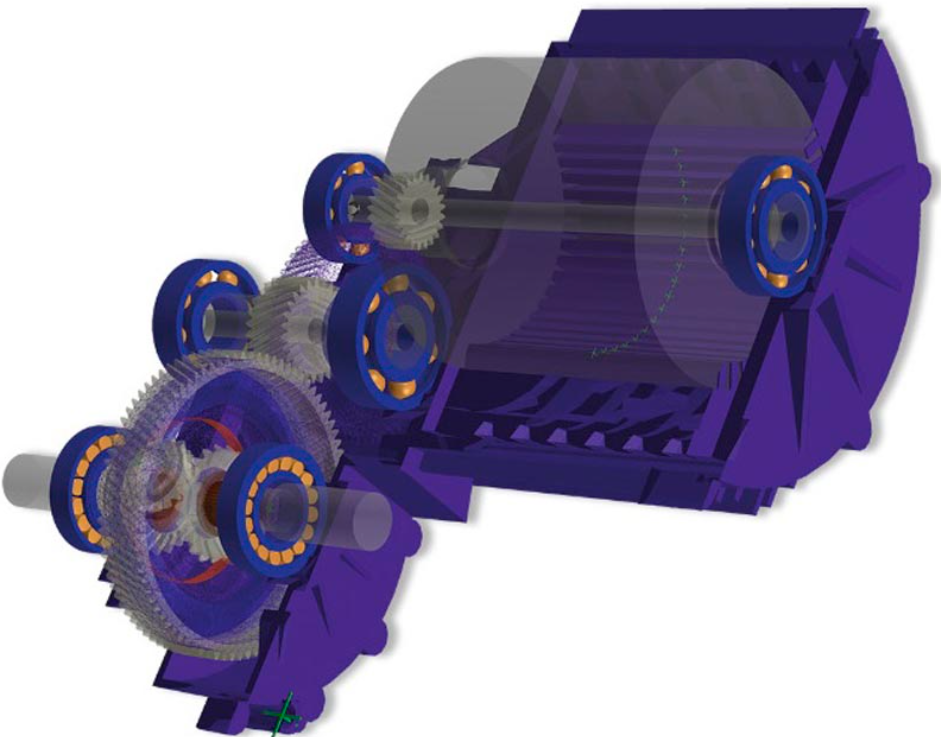Romax Software Updates Bearing Capabilities

Hexagon recently released Romax DT 2023.1, as part of the full Romax software suite. Bearing specialists require independent tools supplying innovative rolling element bearing analysis. These tools will provide the insight needed to design and select bearings for optimum performance and durability, as part of a whole system model. Whether selecting the appropriate bearings for a concept design, designing a custom bearing for a specific application, or performing root cause analysis of a bearing failure, engineers need reliable prediction of bearing performance to make key decisions. In addition, bearing suppliers and OEMs must be able to collaborate and share data with each other, while being independent and preserving valuable IP.
Romax Spin, for example, features detailed modeling of rolling bearings, fast and intuitive modeling of full drive systems, and advanced contact algorithms that accurately capture the non-linear behavior of bearings. Users can calculate load and stress distributions, film thickness, standard ratings such as ISO 281 and ISO/TS 16281 and run dynamic simulations to study phenomena such as skidding and cage dynamics. Dr. Michael Platten, Senior Product Manager—Romax, explains some of the highlights from the 2023.1 release of the Romax software suite which includes updates to Romax Spin. Modeling and Usability: The 2D Worksheet now shows which bearings have 1D raceway connections. This allows users to quickly check all the bearings in a model to see which are configured to have 1D raceway flexibility and which do not. (Note, a similar visual check if bearings have 3D (FE) raceway flexibility is enabled.) Journal Bearings: The operating temperature of the journal bearing lubricant film can now be directly specified. In previous versions, the journal bearing operating temperature was determined as the mean temperature of its shaft and housing. This can now be overridden with a custom value, for example, obtained outside of Romax software, and this temperature will affect the lubricant viscosity used in the journal bearing component calculations. Rolling Element Bearings: Multi-lobe ovalization and custom bearing ring distortion. Rolling bearings may be radially deformed by design from a circular shape to a bi-lobe, tri-lobe, or other geometry to limit skidding. Previously it was possible to define ovalization (i.e. bi-lobe shape) in Romax software. Now, this has been extended to allow multiple lobes and custom shapes, primarily to enable the modeling of tri-lobe raceways, but more lobes or an entirely custom shape are also enabled. This allows parametric investigation of the applied raceway distortion and its impact on load and stress distribution and ring deformation. Previous bearing dynamics capability in Romax Spin has a simplified representation of cages. The cages are considered rigid and they were only allowed to rotate about their own axis. This development addresses one of these limitations by adding lateral and tilt degrees of freedom to the cages, in addition to the rotation about their own axis. This would allow engineers to analyze the lateral motion of a cage and its stability by looking at the whirl orbits under various operating conditions. A new bearing catalog from NTN has been added to Romax software. It is available alongside existing bearing catalogs and offers matching functionality. The catalog data is based on the General Rolling Bearing Catalog issued separately by NTN. As with other bearing supplier catalogs, limited data has been provided by NTN and the rest of the bearing internal and advanced data has been estimated by Romax. The EP Additives setting is now reported alongside the lubricant name and level of contamination in the reports ISO 281 and ISO/TS 16281 Results to give the user more context when reviewing bearing life results. This feature minimizes the effort required to check the status of EP additives on individual bearings. The EP Additives setting is now reported alongside the lubricant name and level of contamination in the reports ISO 281 and ISO/TS 16281 Results and Bearing Certification Report (ISO 281 and ISO/TS 16281) to give the user more context when reviewing bearing life results. This feature minimizes the effort required to check the status of EP additives on individual bearings.
1.The news above mentioned with detailed source are from internet.We are trying our best to assure they are accurate ,timely and safe so as to let bearing users and sellers read more related info.However, it doesn't mean we agree with any point of view referred in above contents and we are not responsible for the authenticity. If you want to publish the news,please note the source and you will be legally responsible for the news published.
2.All news edited and translated by us are specially noted the source"CBCC".
3.For investors,please be cautious for all news.We don't bear any damage brought by late and inaccurate news.
4.If the news we published involves copyright of yours,just let us know.
Next Schaeffler’s OPTIME Ecosystem Balances Plant Assets
BRIEF INTRODUCTION
Cnbearing is the No.1 bearing inquiry system and information service in China, dedicated to helping all bearing users and sellers throughout the world.
Cnbearing is supported by China National Bearing Industry Association, whose operation online is charged by China Bearing Unisun Tech. Co., Ltd.
China Bearing Unisun Tech. Co., Ltd owns all the rights. Since 2000, over 3,000 companies have been registered and enjoyed the company' s complete skillful service, which ranking many aspects in bearing industry at home and abroad with the most authority practical devices in China.



